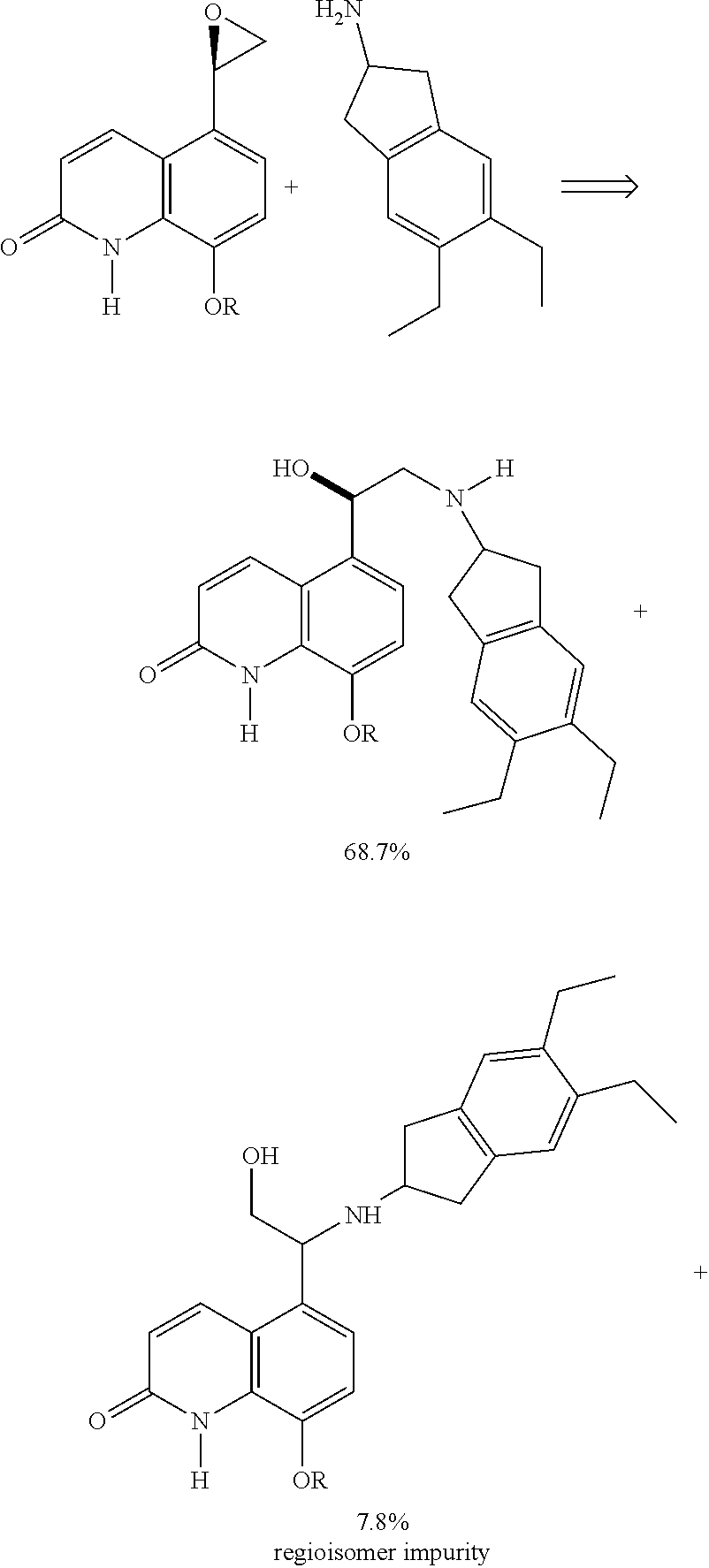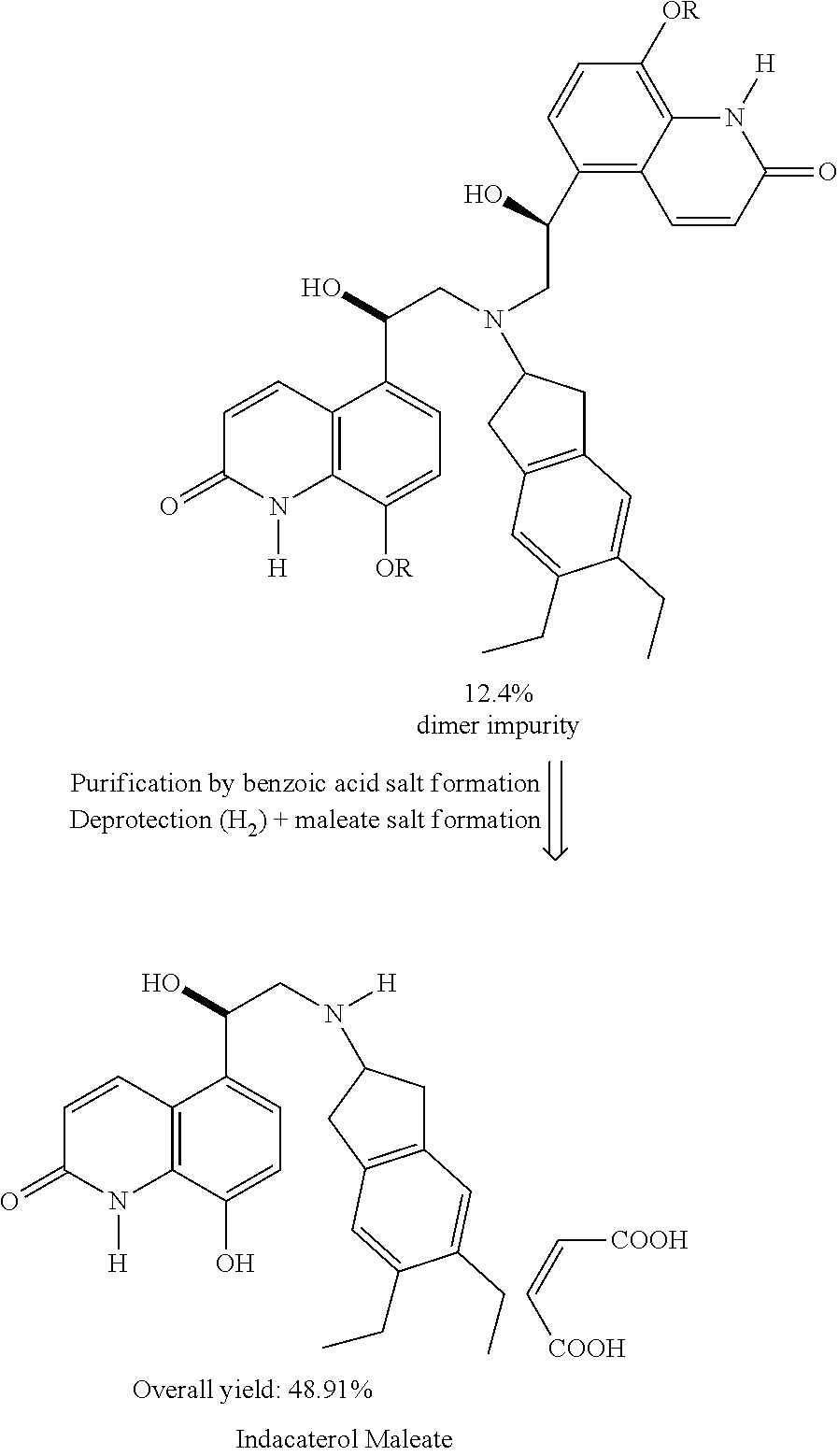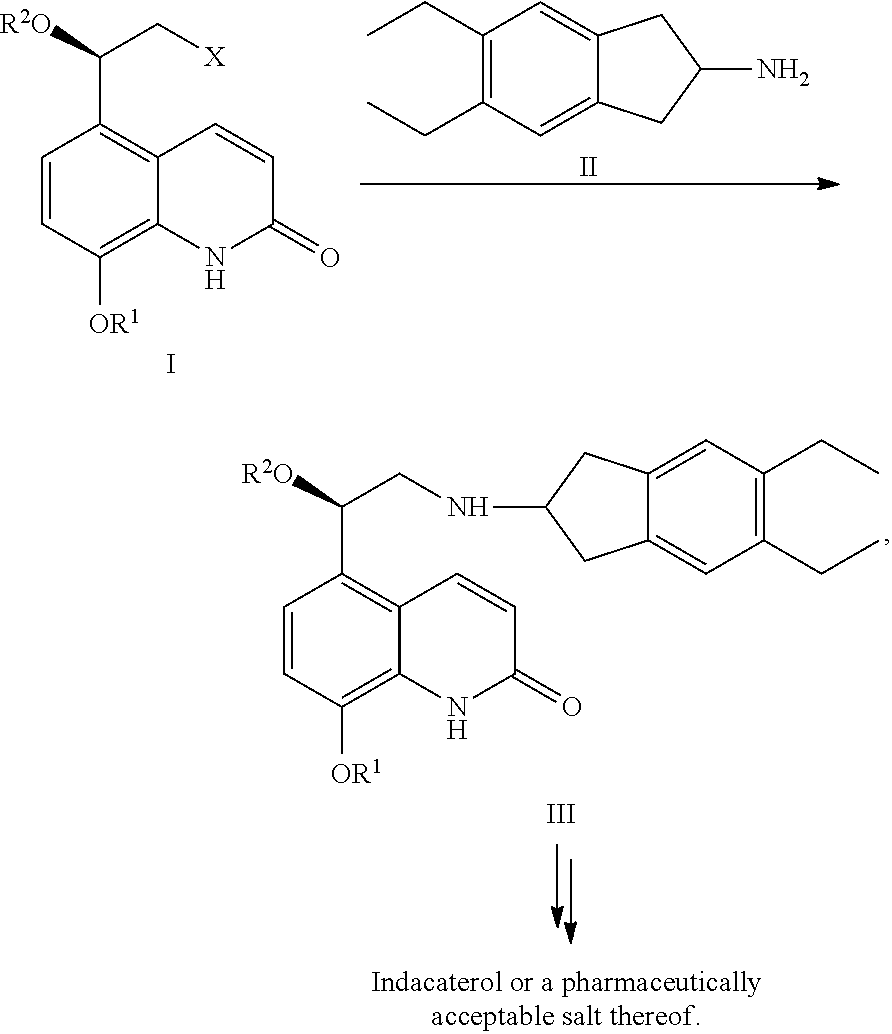Methods for the preparation of indacaterol and pharmaceutically acceptable salts thereof
a technology of indacaterol and salts, which is applied in the field of process for the preparation of indacaterol and pharmaceutically acceptable salts thereof, can solve the problems of only 49% overall yield achieved by the end of the process and inability to proceed via the free base of indacaterol, and achieve the effect of facilitating the purification of the compound
- Summary
- Abstract
- Description
- Claims
- Application Information
AI Technical Summary
Benefits of technology
Problems solved by technology
Method used
Image
Examples
example 1
Protecting the α-halohydroxy Compound of Formula VI
[0071]
[0072]A flask is charged with 5 ml of tetrahydrofuran (THF) and 5 ml of toluene. p-toluene sulfonic acid (0.15 mmol) and molecular sieves are added with stirring for 30 minutes. 6 mmol of butyl-vinylether and 3 mmol of 8-(phenylmethoxy)-5-((R)-2-bromo-1-hydroxy-ethyl)-(1H)-quinolin-2-one are added. The mixture is agitated at 20 / 25° C. until completion of the reaction, followed by filtration and distillation of the filtrate to remove the solvent. The product is obtained in quantitative yield as an oil consisting of 50% of each of the diastereomers.
[0073]1H-NMR (DMSO-d6, δ), mixture 50 / 50 of diastereomers: 0.61 and 0.82 (3H, t, J=7.2 Hz, CH3—Pr—O), 1.12 and 1.22 (3H, d, J=5.6 Hz, acetalic CH3), 0.90-1.40 (4H, m, CH2+CH2), 3.20-3.80 (4H, m, CH2—OAr+CH2—Br), 4.51 and 4.82 (1H, q, J=5.6 Hz, acetalic CH), 5.18 and 5.24 (1H, dd, J=4.0, 8.0 Hz, CH—O-acetal), 6.56 and 6.58 (1H, d, J=10.0 Hz, H4), 7.00-7.57 (7H, m), 8.17 and 8.23 (1H, d...
example 2
Protecting the α-halohydroxy Compound of Formula VI
[0075]
[0076]Pivaloyl chloride (0.72 g) is added to a stirred mixture of 8-(phenylmethoxy)-5-((R)-2-chloro-1-hydroxy-ethyl)-(1H)-quinolin-2-one (0.74 g), dichloromethane (15 ml) and 4-dimethylaminopyridine (0.89 g) at 20 / 25° C., and the reaction is stirred until all the starting material disappeared. Water (22 ml) is added and the phases are separated.
[0077]The organic phase is washed with 1 M HCl (22 ml) and then with water (22 ml). The solvent is removed and the residue is crystallized from acetone to obtain 0.82 g of the product.
[0078]1H-NMR (DMSO-d6, δ): 1.13 (9H, s, CH3), 3.92 (1H, dd, J=4.0, 12.0 Hz, CH2—Br), 4.00 (1H, dd, J=8.4, 12.0 Hz, CH2—Cl), 5.28 (2H, s, Ph-CH2—O), 6.25 (1H, dd, J=4.0, 8.4 Hz, CH—OPiv), 6.59 (1H, d, J=10.0 Hz, H4), 7.15 (1H, d, J=8.4 Hz, H6), 7.20 (1H, d, J=8.4 Hz, H7), 7.27-7.30 (1H, m, Ph), 7.33-7.37 (2H, m, Ph), 7.54-7.56 (2H, m, Ph), 8.18 (1H, d, J=10.0 Hz, H3), 10.77 (1H, s, NH).
[0079]13C-NMR (DMSO-d...
example 3
Preparation of the Compound of Formula IV
[0080]
[0081]A flask is charged with 2.5 ml of THF and 2.5 ml of toluene. p-toluene sulfonic acid (5 mg) and molecular sieves (0.2 g) are added with stirring for 30 minutes. 1.5 ml of butyl-vinylether and 2 g of 8-(phenylmethoxy)-5-((R)-2-bromo-1-hydroxy-ethyl)-(1H)-quinolin-2-one are added. The mixture is agitated at 20 / 25° C. until completion of the reaction. 0.015 ml of diisopropylethyl amine is added, the mixture is filtered, and the solvent is distilled off.
[0082]The residue is dissolved in 6 ml of dimethylformamide (DMF), 1.9 ml of diisoproypylethyl amine, 1.2 g sodium iodide, and 1.5 g of 2-amino-5,6-diethylindane are added and the mixture is heated to 100° C. After completion of the reaction the mixture is cooled to 20 / 25° C., 0.4 ml of concentrated hydrochloric acid and 0.4 ml of water are added, and the mixture is stirred for 30 minutes.
[0083]HPLC analysis shows the expected product with a purity of 75% and being free from the dimer ...
PUM
| Property | Measurement | Unit |
|---|---|---|
| temperatures | aaaaa | aaaaa |
| temperature | aaaaa | aaaaa |
| temperature | aaaaa | aaaaa |
Abstract
Description
Claims
Application Information
 Login to View More
Login to View More - R&D
- Intellectual Property
- Life Sciences
- Materials
- Tech Scout
- Unparalleled Data Quality
- Higher Quality Content
- 60% Fewer Hallucinations
Browse by: Latest US Patents, China's latest patents, Technical Efficacy Thesaurus, Application Domain, Technology Topic, Popular Technical Reports.
© 2025 PatSnap. All rights reserved.Legal|Privacy policy|Modern Slavery Act Transparency Statement|Sitemap|About US| Contact US: help@patsnap.com



